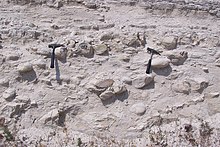Secondary sedimentary structures are those which formed after
deposition. Such structures form by chemical, physical and biological
processes within the sediment. They can be indicators of circumstances
after deposition. Some can be used as way up criteria.
Organic materials in a sediment can leave more traces than just fossils. Preserved tracks and burrows are examples of trace fossils (also called ichnofossils).[34] Such traces are relatively rare. Most trace fossils are burrows of molluscs or arthropods. This burrowing is called bioturbation
by sedimentologists. It can be a valuable indicator of the biological
and ecological environment that existed after the sediment was
deposited. On the other hand, the burrowing activity of organisms can
destroy other (primary) structures in the sediment, making a
reconstruction more difficult.
Secondary structures can also form by diagenesis or the formation of a soil (pedogenesis) when a sediment is exposed above the water level. An example of a diagenetic structure common in carbonate rocks is a stylolite.[35]
Stylolites are irregular planes where material was dissolved into the
pore fluids in the rock. This can result in the precipitation of a
certain chemical species producing colouring and staining of the rock,
or the formation of concretions.
Concretions are roughly concentric bodies with a different composition
from the host rock. Their formation can be the result of localized
precipitation due to small differences in composition or porosity of the
host rock, such as around fossils, inside burrows or around plant
roots.[36] In carbonate based rocks such as limestone or chalk, chert or flint concretions are common, while terrestrial sandstones can have iron concretions. Calcite concretions in clay are called septarian concretions.
After deposition, physical processes can deform
the sediment, producing a third class of secondary structures. Density
contrasts between different sedimentary layers, such as between sand and
clay, can result in flame structures or load casts, formed by inverted diapirism.[37]
While the clastic bed is still fluid, diapirism can cause a denser
upper layer to sink into a lower layer. Sometimes, density contrasts can
result or grow when one of the lithologies dehydrates. Clay can be
easily compressed as a result of dehydration, while sand retains the
same volume and becomes relatively less dense. On the other hand, when
the pore fluid pressure in a sand layer surpasses a critical point, the sand can break through overlying clay layers and flow through, forming discordant bodies of sedimentary rock called sedimentary dykes. The same process can form mud volcanoes on the surface where they broke through upper layers.
Sedimentary dykes can also be formed in a cold climate where the soil
is permanently frozen during a large part of the year. Frost weathering
can form cracks in the soil that fill with rubble from above. Such
structures can be used as climate indicators as well as way up
structures.[38]
Density contrasts can also cause small-scale faulting, even while sedimentation progresses (synchronous-sedimentary faulting).[39]
Such faulting can also occur when large masses of non-lithified
sediment are deposited on a slope, such as at the front side of a delta or the continental slope. Instabilities in such sediments can result in the deposited material to slump, producing fissures and folding. The resulting structures in the rock are syn-sedimentary folds and faults, which can be difficult to distinguish from folds and faults formed by tectonic forces acting on lithified rocks.

No comments:
Post a Comment